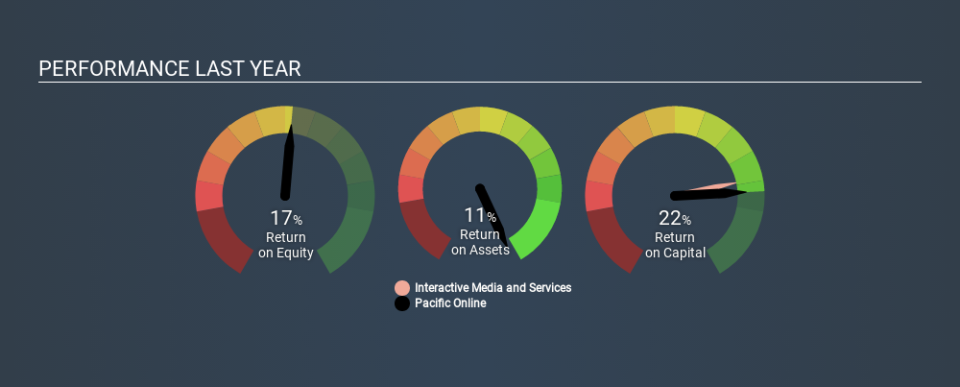Is Pacific Online Limited’s (HKG:543) 22% ROCE Any Good?

Today we'll evaluate Pacific Online Limited (HKG:543) to determine whether it could have potential as an investment idea. Specifically, we're going to calculate its Return On Capital Employed (ROCE), in the hopes of getting some insight into the business.
Firstly, we'll go over how we calculate ROCE. Second, we'll look at its ROCE compared to similar companies. Finally, we'll look at how its current liabilities affect its ROCE.
Return On Capital Employed (ROCE): What is it?
ROCE is a metric for evaluating how much pre-tax income (in percentage terms) a company earns on the capital invested in its business. In general, businesses with a higher ROCE are usually better quality. Ultimately, it is a useful but imperfect metric. Renowned investment researcher Michael Mauboussin has suggested that a high ROCE can indicate that 'one dollar invested in the company generates value of more than one dollar'.
How Do You Calculate Return On Capital Employed?
Analysts use this formula to calculate return on capital employed:
Return on Capital Employed = Earnings Before Interest and Tax (EBIT) ÷ (Total Assets - Current Liabilities)
Or for Pacific Online:
0.22 = CN¥212m ÷ (CN¥1.3b - CN¥382m) (Based on the trailing twelve months to June 2019.)
So, Pacific Online has an ROCE of 22%.
View our latest analysis for Pacific Online
Is Pacific Online's ROCE Good?
ROCE can be useful when making comparisons, such as between similar companies. In our analysis, Pacific Online's ROCE is meaningfully higher than the 14% average in the Interactive Media and Services industry. I think that's good to see, since it implies the company is better than other companies at making the most of its capital. Setting aside the comparison to its industry for a moment, Pacific Online's ROCE in absolute terms currently looks quite high.
The image below shows how Pacific Online's ROCE compares to its industry, and you can click it to see more detail on its past growth.
Remember that this metric is backwards looking - it shows what has happened in the past, and does not accurately predict the future. ROCE can be deceptive for cyclical businesses, as returns can look incredible in boom times, and terribly low in downturns. ROCE is only a point-in-time measure. You can check if Pacific Online has cyclical profits by looking at this free graph of past earnings, revenue and cash flow.
Pacific Online's Current Liabilities And Their Impact On Its ROCE
Current liabilities are short term bills and invoices that need to be paid in 12 months or less. The ROCE equation subtracts current liabilities from capital employed, so a company with a lot of current liabilities appears to have less capital employed, and a higher ROCE than otherwise. To counter this, investors can check if a company has high current liabilities relative to total assets.
Pacific Online has current liabilities of CN¥382m and total assets of CN¥1.3b. As a result, its current liabilities are equal to approximately 29% of its total assets. A minimal amount of current liabilities limits the impact on ROCE.
Our Take On Pacific Online's ROCE
, Pacific Online looks strong on this analysis, but there are plenty of other companies that could be a good opportunity . Here is a free list of companies growing earnings rapidly.
I will like Pacific Online better if I see some big insider buys. While we wait, check out this free list of growing companies with considerable, recent, insider buying.
If you spot an error that warrants correction, please contact the editor at editorial-team@simplywallst.com. This article by Simply Wall St is general in nature. It does not constitute a recommendation to buy or sell any stock, and does not take account of your objectives, or your financial situation. Simply Wall St has no position in the stocks mentioned.
We aim to bring you long-term focused research analysis driven by fundamental data. Note that our analysis may not factor in the latest price-sensitive company announcements or qualitative material. Thank you for reading.

